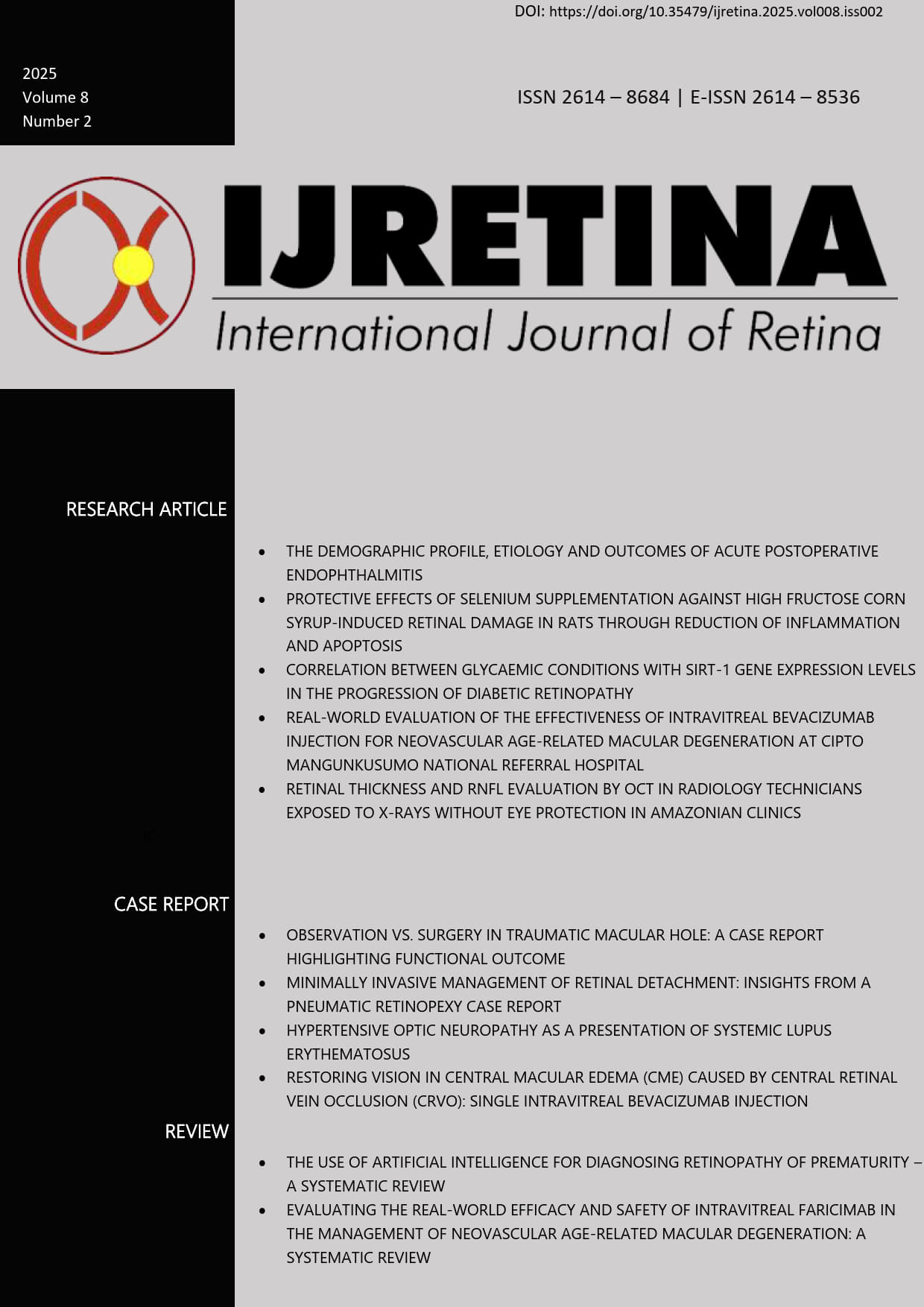PROTECTIVE EFFECTS OF SELENIUM SUPPLEMENTATION AGAINST HIGH FRUCTOSE CORN SYRUP-INDUCED RETINAL DAMAGE IN RATS THROUGH REDUCTION OF INFLAMMATION AND APOPTOSIS
Main Article Content
Abstract
Introduction: High fructose corn syrup (HFCS) consumption is associated with metabolic complications, including retinopathy. The aim of the current study is to investigate the potential protective effect of selenium (Se) against HFCS-induced retinal damage.
Methods: Forty Wistar albino rats were divided into four groups (n=7 each): (I) control; (II) high fructose corn syrup (HFCS, 20% in diet); (III) HFCS + Se (20% in diet, 0.3 mg/kg orally); (IV) Se only. Retinal damage was assessed using histopathological (retinal thickness) and immunohistochemical (TNF-α, and Cas-3 expression) analysis.
Results: Retinal thickness measurements revealed a significant increase in the HFCS group compared to the Control group, HFCS+Se group and Se group (all group, p<0.0001). Immunohistochemical analysis showed increased TNF-α expression in the HFCS group compared to the Control and Se groups (p<0.01), with a non-significant decrease in the HFCS+Se group (p > 0.05). Cas-3 expression was significantly increased in the HFCS group compared to the Control, Se groups (p<0.001 for both) and HFCS+Se group (p<0.01).
Conclusion: Se supplementation partially protects against HFCS-induced retinal damage, particularly by reducing inflammation and apoptosis.
Keywords
High fructose corn syrup, Retinal damage, Selenium, TNF-α, Caspase-3
Article Details

This work is licensed under a Creative Commons Attribution-NonCommercial 4.0 International License.
References
1. Wang HH, Lee DK, Liu M, et al. Novel insights into the pathogenesis and management of the metabolic syndrome. Pediatr Gastroenterol Hepatol Nutr 2020;23(3):189; doi: 10.5223/PGHN.2020.23.3.189.
2. Gao L, Xin Z, Yuan MX, et al. High prevalence of diabetic retinopathy in diabetic patients concomitant with metabolic syndrome. PLoS One 2016;11(1):e0145293; doi: 10.1371/journal.pone.0145293.
3. Zhao Y, Wang QY, Zeng LT, et al. Long-Term High-Fat High-Fructose Diet Induces Type 2 Diabetes in Rats through Oxidative Stress. Nutrients 2022;14(11):2181; doi: 10.3390/nu14112181.
4. Kearney FM, Fagan XJ, Al-Qureshi S. Review of the role of refined dietary sugars (fructose and glucose) in the genesis of retinal disease. Clin Exp Ophthalmol 2014;42(6):564–573; doi: 10.1111/ceo.12290.
5. Lima-Fontes M, Barata P, Falcão M, et al. Ocular findings in metabolic syndrome: a review. Porto Biomed J 2020;5(6):104; doi: 10.1097/j.pbj.0000000000000104.
6. Asare-Bediako B, Noothi SK, Li Calzi S, et al. Characterizing the Retinal Phenotype in the High-Fat Diet and Western Diet Mouse Models of Prediabetes. Cells 2020;9(2); doi: 10.3390/cells9020464.
7. Abdel-Kawi SH, Hassanin KMA, Hashem KS. The effect of high dietary fructose on the kidney of adult albino rats and the role of curcumin supplementation: A biochemical and histological study. Beni-Suef Univ J Basic Appl Sci 2016;5(1):52–60; doi: 10.1016/j.bjbas.2015.12.002.
8. Bratoeva K, Nikolova S, Merdzhanova A, et al. Association between serum CK-18 levels and the degree of liver damage in fructose-induced metabolic syndrome. Metab Syndr Relat Disord 2018;16(7):350–357; doi: 10.1089/met.2017.0162.
9. Hussain Y, Jain SK, Samaiya PK. Short-term westernized (HFFD) diet fed in adolescent rats: Effect on glucose homeostasis, hippocampal insulin signaling, apoptosis and related cognitive and recognition memory function. Behav Brain Res 2019;361:113–121; doi: 10.1016/j.bbr.2018.12.042.
10. Cheng SM, Cheng YJ, Wu LY, et al. Activated apoptotic and anti-survival effects on rat hearts with fructose induced metabolic syndrome. Cell Biochem Funct 2014;32(2):133–141; doi: 10.1002/cbf.2982.
11. Yang M, Zhao T, Deng T, et al. Protective effects of astaxanthin against diabetic retinal vessels and pro-inflammatory cytokine synthesis. Int J Clin Exp Med 2019;12(5):4725–4734.
12. Kowluru RA, Koppolu P. Diabetes-induced activation of caspase-3 in retina: Effect of antioxidant therapy. Free Radic Res 2002;36(9):993–999; doi: 10.1080/1071576021000006572.
13. Vidal E, Lalarme E, Maire MA, et al. Early impairments in the retina of rats fed with high fructose/high fat diet are associated with glucose metabolism deregulation but not dyslipidaemia. Sci Rep 2019;9(1):1–11; doi: 10.1038/s41598-019-42528-9.
14. Kommula SR, Chekkilla UK, Ganugula R, et al. Garlic ameliorates long-term pre-diabetes induced retinal abnormalities in high fructose fed rat model. Indian J Exp Biol 2020;(March 2022); doi: 10.56042/ijeb.v58i07.65590.
15. Vunta H, Belda BJ, Arner RJ, et al. Selenium attenuates pro-inflammatory gene expression in macrophages. Mol Nutr Food Res 2008;52(11):1316–1323; doi: 10.1002/mnfr.200700346.
16. Vunta H, Davis F, Palempalli UD, et al. The anti-inflammatory effects of selenium are mediated through 15-deoxy-Δ12,14-prostaglandin J2 in macrophages. J Biol Chem 2007;282(25):17964–17973; doi: 10.1074/jbc.M703075200.
17. Xu J, Gong Y, Sun Y, et al. Impact of Selenium Deficiency on Inflammation, Oxidative Stress, and Phagocytosis in Mouse Macrophages. Biol Trace Elem Res 2020;194(1):237–243; doi: 10.1007/s12011-019-01775-7.
18. González De Vega R, García M, Fernández-Sánchez ML, et al. Protective effect of selenium supplementation following oxidative stress mediated by glucose on retinal pigment epithelium. Metallomics 2018;10(1):83–92; doi: 10.1039/c7mt00209b.
19. McCarty MF. The putative therapeutic value of high-dose selenium in proliferative retinopathies may reflect down-regulation of VEGF production by the hypoxic retina. Med Hypotheses 2005;64(1):159–161; doi: 10.1016/j.mehy.2002.11.003.
20. Yazici A, Aksit H, Sari ES, et al. Comparison of pre-treatment and post-treatment use of selenium in retinal ischemia reperfusion injury. Int J Ophthalmol 2015;8(2):263–268; doi: 10.3980/j.issn.2222-3959.2015.02.09.
21. Alfonso-Muñoz EA, Burggraaf-Sánchez de las Matas R, Mataix Boronat J, et al. Role of oral antioxidant supplementation in the current management of diabetic retinopathy. Int J Mol Sci 2021;22(8); doi: 10.3390/ijms22084020.
22. Rübsam A, Parikh S, Fort PE. Role of Inflammation in Diabetic Retinopathy. Int J Mol Sci 2018;19(4); doi: 10.3390/ijms19040942.
23. Kearney FM, Fagan XJ, Al-Qureshi S. Review of the role of refined dietary sugars (fructose and glucose) in the genesis of retinal disease. Clin Exp Ophthalmol 2014;42(6):564–573; doi: 10.1111/ceo.12290.
24. Pahwa R, Nallasamy P, Jialal I. Toll-like receptors 2 and 4 mediate hyperglycemia induced macrovascular aortic endothelial cell inflammation and perturbation of the endothelial glycocalyx. J Diabetes Complications 2016;30(4):563–572; doi: 10.1016/j.jdiacomp.2016.01.014.
25. Zhang W, Wang Y, Kong Y. Exosomes derived from mesenchymal stem cells modulate miR-126 to ameliorate hyperglycemia-induced retinal inflammation via targeting HMGB1. Investig Ophthalmol Vis Sci 2019;60(1):294–303; doi: 10.1167/iovs.18-25617.
26. Mirshahi A, Hoehn R, Lorenz K, et al. Anti-tumor necrosis factor alpha for retinal diseases: Current knowledge and future concepts. J Ophthalmic Vis Res 2012;7(1):39–44.
27. Altmann C, Schmidt MHH. The Role of Microglia in Diabetic Retinopathy: Inflammation, Microvasculature Defects and Neurodegeneration. Int J Mol Sci 2018;19(1); doi: 10.3390/ijms19010110.


 http://orcid.org/0000-0002-0065-4384
http://orcid.org/0000-0002-0065-4384